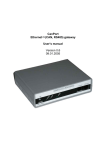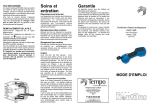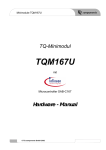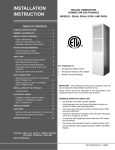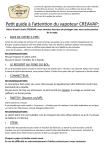Download ELF2–PP User`s manual
Transcript
ELF2–PP E1 over IP gateway User’s manual Software release 2.03PP 2 © PARABEL, ltd ALL RIGHTS RESERVED ELF2-PP E1 over IP gateway USER’S MANUAL RELEASE 2.03PP, August 2005 PARABEL LIMITED P.O. BOX 126 NOVOSIBIRSK-90 RUSSIAN FEDERATION Web: www.parabel-labs.com Email: info[at]parabel.ru Phone/Fax: +7-383-2138707 3 4 CONTENTS 1. Introduction ..............................................................................................................................................7 2. Gateway installation ...............................................................................................................................8 2.1. Front Panel Controls, Connectors, and Indicators of ELF2-PP ...............................................8 2.2. Sockets description.........................................................................................................................9 3. Gateway configuration .........................................................................................................................10 3.1. E1 port configuration.....................................................................................................................10 3.2. IP interface configuration .............................................................................................................10 3.3. Configuring routes.........................................................................................................................11 3.4. General commands.......................................................................................................................11 3.4.1. Help (help)...............................................................................................................................11 3.4.2. Remote access control (access) .........................................................................................11 3.4.3. Saving the current configuration (write)..............................................................................12 3.4.4. Hot restart (reboot) ................................................................................................................12 3.4.5. Pinging (ping)..........................................................................................................................12 3.5. Configuring E1 over IP channel ..................................................................................................12 3.6. Recommendations about E1 over IP usage .............................................................................13 3.6.1. E1 configuration .....................................................................................................................13 3.6.2. Encapsulation parameters....................................................................................................13 4. Net statistics and gateway monitoring...............................................................................................14 4.1. E1 port state...................................................................................................................................14 4.2. E1 over IP channel state ..............................................................................................................15 5. Boot loader ............................................................................................................................................15 5.1. Boot loader console ......................................................................................................................15 5.2. Boot loader parameters editing...................................................................................................15 5.3. Boot loader service commands...................................................................................................16 5.4. Gateway firmware upgrading ......................................................................................................16 6. Gateway delivery ..................................................................................................................................17 7. Packaging ..............................................................................................................................................17 5 FIGURES Figure 1. The front panel of ELF2-PP......................................................................................................8 Figure 2. ELF2-PP back panel..................................................................................................................8 6 1. Introduction The ELF2-PP gateway is intended for E1 data transmission through the packet network. The device enables to organize traditional telephone channels based on the Ethernet infrastructure. Being more suitable alternative in certain instances, this approach considerably simplifies telephone channel installation and operation as compared with VoIP. The ELF2-PP gateway requirements are the following: • • • separated broadband transmission line with 10Base-T or 100Base-T QOS support for the Ethernet switching when simultaneous voice and data transmitting small round-trip delay not more than 30 ms, otherwise E1 echo suppressors should be used The distinctive features of the ELP2-PP gateway are as follows: • • • • • • transparency for the telephone signalization protocols, both CSS and CAS Exact E1 frame and multiframe regeneration Exact time and frequency parameters reproduction of signal G.703 packet delay Jitter Buffer compensation Use of UDP or Ethernet packets for E1 data encapsulation Packet and jitter buffer sizing adjustment The functional block diagram of the gateway is given below. E1 Framer Jitter Buffer Packet Processor E1A port IP processor Ethernet port This device is more preferably used for the following applications: • remote multi-channel telephone terminals with help of wireless technology 802.11 • E1 channels for PBX connection over data networks 7 2. Gateway installation 2.1. Front Panel Controls, Connectors, and Indicators of ELF2-PP There are the following indicators on the front panel: • Reset button (Reset) • Power led (Power) • 100 Mbit Ethernet mode led (100TX) • Ethernet link led (Link) • E1 led, port a (E1-a) • Console socket RJ-11 (6-pin console RJ-11) Figure 1. The front panel of ELF2-PP There are the following sockets on the back panel: • 8-pin Ethernet socket - RJ-45 • 8-pin E1-A socket - RJ-45 • Power socket (DC) Figure 2. ELF2-PP back panel 8 2.2. Sockets description Contact 1 2 3 4 5 6 7 8 Net TX+ TXRX+ RX- Table 1. Ethernet socket Contact 1 2 3 4 5 6 7 8 Net RX+ RXTX+ TX+ GND GND Table 2. Socket E1A Contact 1 2 3 4 5 6 Net RXD TXD GND GND Direction input output Table 3. Console socket 9 3. Gateway configuration ELF2-PP can be configured via console port or remotely with help of Telnet Protocol. A console port is connected to the serial port of PC by adapter cable RJ-11 ÅÆ DB-9. The gateway is controlled by the terminal program with parameters: 38400, 8b, 1s, np, flow control=off (use Teraterm, for example). Device parameters are specified by command language, described in this chapter. 3.1. E1 port configuration E1 port parameters are configured with help of e1 command: e1 [clock=line|int] e1 [frame=on|off] e1 [timeslot=all|range] e1 [cfg] where clock=line – E1 port is synchronized with the line (slave mode) clock=int – E1 port is internally synchronized (master mode) frame=off – E1 port is in an unstructured mode (the whole E1 stream is transmitted transparently). The working bandwidth is 2048 kbit/s + overhead. frame=on –E1 port works in a structured mode, the timeslots specified by the parameter timeslot are restored. The used bandwidth is 64 + N * 64 kbit/s +overhead timeslot=all – every original E1 stream timeslot is transmitted and restored timeslot=range –timeslots defined by the parameter range are transmitted and restored. The range is specified by enumeration of timeslot numbers. The numbers are separated by commas or hyphen, f.e., 1,3,6- 19. Timeslot 0 is transmitted and restored anyway. cfg – E1 configuration is displayed. 3.2. IP interface configuration ipif command is used for IP interface configuration: ipif [no] [addr=x.x.x.x] [mask=x.x.x.x] ipif [bootp=on|off] ipif [clear] ipif [up | down] [cfg] where, no – removes the address addr – specifies the ip interface address mask – specifies interface net mask bootp – responds (on) or not (off) to the request of bootp address and mask upon start up clear – clears statistics up – activates the interface down – closes the interface cfg – displays IP interface configuration Example ipif no addr=192.168.1.4 ipif addr=192.168.1.6 mask=255.255.255.0 ipif addr=192.168.2.6 mask=255.255.255.0 In this case the old IP address is removed and two new addresses are added 10 3.3. Configuring routes The command ‘route’ can add and remove the IP routes. This command also presents the routing table configuration. There are several kinds of routes: host route, net-route, direct or indirect route. To add a host route, it is necessary only to enter IP address of host. To add a netroute, both IP address and net mask should be entered. Direct routes are meant for hosts in the same Ethernet segment as for the gateway. Indirect routes are intended for the hosts which are available via the IP gateway. In this case the IP gateway address should be indicated. The command has syntax: route [no] addr=x.x.x.x [mask=y.y.y.y] [gwip=z.z.z.z] route cfg where no – route removal addr – host or subnet address mask – net mask (for net routes) gwip – IP gateway address cfg – routing table is displayed Note. • The default route is specified with IP address 0.0.0.0 or ‘default’. A default route should be used, in case if there are no specified routes for packet delivery. • The IP interface subnet is added automatically. Example route addr=default gwip=192.168.2.6 This command specifies the route on default IP gateway 192.168.2.6. 3.4. General commands 3.4.1. Help (help) This command enables to display the whole list of the system commands. To get ‘help’ of a separate command, the command name should be entered without parameters and then <enter> is pressed. 3.4.2. Remote access control (access) access [telnet=on|off] [user=%s] [pswd=%s] access cfg telnet – enables or disables the remote telnet configuration user – defines a user’s name (login) for telnet users. User name is a text string without spaces, up to 32 symbols length. Empty name is null. pswd – define password for telnet users. Password is a text string without spaces, keeping up to 32 symbols. ’null’ means an empty password. cfg – prints current parameters values All the parameters of the command access are checked upon start up of the system without the further analyzing. 11 3.4.3. Saving the current configuration (write) Full gateway configuration is a set of command lines required for restoring all parameters after restart. There are two copies of configuration information – current (running) and saved in volatile memory (flash). The current configuration is changed by an operator while entering new commands. To copy the current configuration to the flash memory command write flash is used. 3.4.4. Hot restart (reboot) To reload the software, command reboot should be used without parameters. 3.4.5. Pinging (ping) To check IP host accessibility command ping can be used. ping [c %d] [s %d] ipaddr Parameter c defines transmitted packets quantity (from 1 to 50). Parameter s defines a packet size (up to 2048 bytes). ipaddr is a host IP address represented in dot notation, for example 192.168.1.1. 3.5. Configuring E1 over IP channel epipe command is used for configuring E1 over IP parameters. epipe [encaps=raw|udp] [peer=x.x.x.x] epipe [jbsize=%d] [fpp=%d] epipe [tos=%x] [udpport=%d] epipe [cfg] epipe [up] [down] where, encaps=raw - E1 data is encapsulated into raw Ethernet packets. Overhead is 28 bytes per packet (including CRC). encaps=udp – E1 data is encapsulated into UDP packets. Overhead is 56 bytes/packet (including CRC). peer – defines IP address of peer E1 gateway. Two E1 gateways should have complimentary pair of IP addresses, which are defined by commands epipe peer and ipif addr. jbsize – defines jitter buffer size (packets). The permitted value varies from 8 to 128. The large jbsize value can provide large speech delay and echo. The small jbsize value can cause loss of synchronization. fpp – defines the number of E1 frames transmitted in one packet. Small value may lead to large overhead and large value can cause speech echo. The recommendations on the choice of jbsize and fpp values are presented in another chapter. 12 tos – defines the TOS field of IP headers relative to E1 traffic (0..ff) *. The TOS field can be used by external Ethernet switches and routers for the high priority assignment for E1 data packets with voice data. This TOS value is set only for the outgoing packets with E1 traffic. Other service packets are sent with TOS value 0. In the ingoing packets the TOS field is negligible. TOS default parameter is 0. The TOS bits assignment is presented in the table **. 0 1 2 3 4 5 6 7 PRECEDENCE D T R 0 0 PRECEDENCE: 111 – Network Control 110 – Internetwork control 101 - CRITIC/ECP 100 - Flash override 011 - Flash 010 - Immediate 001 - Priority 000 - Routine D=0 – Normal Delay D=1 – Low Delay T=0 – Normal Throughput T=1 – High Throughput R=0 – Normal Reliability R=1 – High Reliability Notes: * if encaps=raw, TOS field is ignored ** TOS is defined by RFC791 and presented here only for reference udpport – UDP port for E1 data channel. On default udpport=5397. For service purposes udpport+1 is used also. cfg – displays the current values of parameters up – activates the channel down – closes the channel, stops the transmission 3.6. Recommendations about E1 over IP usage 3.6.1. E1 configuration The pair of E1 gateways, which creates E1 channel, should operate in master-slave configuration. The slave gateway should have parameter clock=line. The master gateway should have parameter clock=int. The slave gateway is attached to the external E1 master channel. The master gateway is attached to the external E1 slave channel. So, following this master-slave-master-slave configuration is a major requirement for avoiding slip/skip errors. The slave gateway in this configuration will adjust E1 carrier frequency to the master E1 equipment. The ELF2 master will be adjusted to the frequency of the E1 master. The number of frequency shifts can be observed in VCO-/VCO+ field of show epipe command. 3.6.2. Encapsulation parameters The choice of an encapsulation method depends on the Ethernet transport network. For flat layer-2 networks raw Ethernet encapsulation is recommended for minimization of header overhead. If there are routers in the data path, UDP encapsulation should be set. 13 The value of fpp parameter influences on the optimal Ethernet channel usage. For example, if fpp=4, there are 32 * fpp = 128 data bytes in one packet. If header size is 28 bytes, effective channel usage is 82%. If fpp=8 channel usage is 90%. At the same time increase of fpp value leads to the delay equal 0.125 * fpp (ms) in the E1 channel. When jbsize parameter is chosen, the dispersion of the packets propagation time should be taken into consideration. First, it is recommended to set the maximum size of the jitter buffer (jbsize=128) and detect the current propagation time dispersion (field Max jitter, show epipe command). Then jbsize parameter is entered. It should be at least double of Max jitter parameter. Voice delay in jitter buffer is 0.125 * jbsize * fpp (ms). jbsize and fpp parameters should be equal for both the peer gateways. If increment in the counters of Jitter buffer underrun/overrun (command show epipe) occurs while operating, it indicates insufficient value of jbsize. The real voice delay in the virtual E1 channel is evaluated as follows: T (ms) = 0.125 * jbsize * fpp + D, where D – packets delay in the Ethernet backbone. The value of D is measured and displayed in the field round trip time (command show epipe). The large value of voice delay can lead to echo effects in the voice channels. In this case external echo canceller is recommended. Recommended parameters values are: fpp=16, jbsize=16, encaps=udp 4. Net statistics and gateway monitoring ELF2 collects statistics information, which can be used for net traffic analysis. The collected information on statistics is displayed if command show is entered. show [route] [tcp] [udp] [ip] [icmp] [buffers] show [running-config] [configuration] [system] show [ipif] [e1] [epipe] where, route – shows the route table tcp –lists tcp protocol statistics udp – lists udp protocol statistics ip – lists ip protocol statistics icmp – lists icmp protocol statistics buffers – lists memory usage statistics running-config – lists current configuration configuration – shows flash configuration system – lists CPU utilization statistics ipif – lists ip interfaces statistics e1 – shows E1 port state epipe – shows E1 over IP channel state 4.1. E1 port state The following information on alarm signals is presented: LOS – carrier is lost LOF – E1 frame is lost LOM – E1 multiframe is lost The prefix "no” before corresponding abbreviation means alarm absence. 14 4.2. E1 over IP channel state The numbers of received/transmitted packets over E1 port are displayed in the Rx/Tx packets fields. As a general rule, after the E1 channel providing, the increment in Tx packets field begins. The internal errors are displayed in the Giant, Non-octet, Aborted, Overrun, Busy, Underrun fields. These counters in operating mode should not have any increment. Late in sequence – the number of delayed packets Lost in sequence – the number of lost packets, when packet sequence is broken Jitter buffer underrun/overrun – the number of underflows/overflows in the jitter buffer VCO-/VCO+ - the number of E1 frequency regulations (only for a master device) Current round trip time – current round-trip time required for Ethernet packets Average round trip time – average round trip time for Ethernet packets Max jitter – maximum delay jitter of the Ethernet packets Jitter buffer delay –calculated packets delay in the jitter buffer. It depends on parameters jbsize and fpp. The standard situation when Max jitter is smaller than Jitter buffer delay. Current queue size – the current number of packets in the jitter buffer. This value varies in the 1..jbsize range. Pipe state – state of E1 channel via IP (‘connected’ indicates the state of being connected); ‘disconnected’ indicates off mode) 5. Boot loader After power on, the boot loader executes the device control. On default, the boot loader starts loading gateway software. The boot process can be interrupted by a user just pressing any key in the console window. The command prompt of the boot loader appears. In this mode some parameters of the boot loader can be configured. Boot loader has the following functions: • Gateway flash memory programming • Memory test and dump • Ethernet tests (ARP, PING) The parameters of the boot loader are structured in the menu system (press <h>, <Enter> to list current menu). These parameters can be saved in the flash memory. 5.1. Boot loader console Attach console cable to PC serial port and start terminal program with parameters: baud 38400, 8 bit, no parity, flow control = off. 5.2. Boot loader parameters editing In the opt menu, some parameters of the boot loader can be configured. The main parameters are listed: myip - IP address of the boot loader servip - IP address of the TFTP server gwip - gateway IP address mask - network mask 15 file - name of a file loaded from the TFTP server loadptr – memory address for image file loading. It should be 0 jumpptr – address for software start. It should be 0x10000 bootstr – command string. It is not essential. list – prints values of all boot loader parameters flags – jump into flags menu The flags must be set to the following: verbose mode off standalone tftp server on enable auto load after startup on enable auto jump after startup on enable auto fflash after startup off copy vxstr to ram off watchdog timer off update – save parameters in the flash memory 5.3. Boot loader service commands The boot loader performs the following functions according to the commands below: pings –goes to ICMP echo server mode and accepts ‘ping’ request of other stations. This mode provides the check of local net connection. Network parameters (IP address, mask, and gateway) should be set before starting this command. bootp –requests network parameters from BOOTP server arp – resolves server IP address (sends ARP request) mdump – dumps memory region mfill –fills memory region mtest – tests memory region fflash – makes flash memory programming (file, myip, servip, mask, gwip must be configured first). Other commands are intended for factory testing. 5.4. Gateway firmware upgrading To write a new software version the following steps should be taken: • Start the TFTP server program on the PC and let gain the read access to a certain folder in the PC filesystem. • Copy image.bin file with the gateway software image to this folder • Attach the console and Ethernet cables to the gateway • Start the terminal program on the PC and set com port parameters: 34800, 8 bit, 1 stop, no parity. • Restart the gateway (reboot command). • Stop boot process (press any key in the terminal). After that the gateway will operate in the boot loader mode. • if required, change the IP address of the boot loader or the server and as well as the net mask (opt menu of a boot loader). • Programming starts with fflash command: boot> fflash<CR> 16 6. Gateway delivery ELF2-PP gateway is shipped with the following accessories: • gateway – 1pc. • Console cable (RJ11-DB9) – 1 pc. • CD disk with documentation – 1 pc. The following accessories can be shipped separately: • Power source AC 220V • Power source DC 36..72В 7. Packaging Gateway is packaged to a carton box with dimensions 26x21x6.5 cm. 17

















